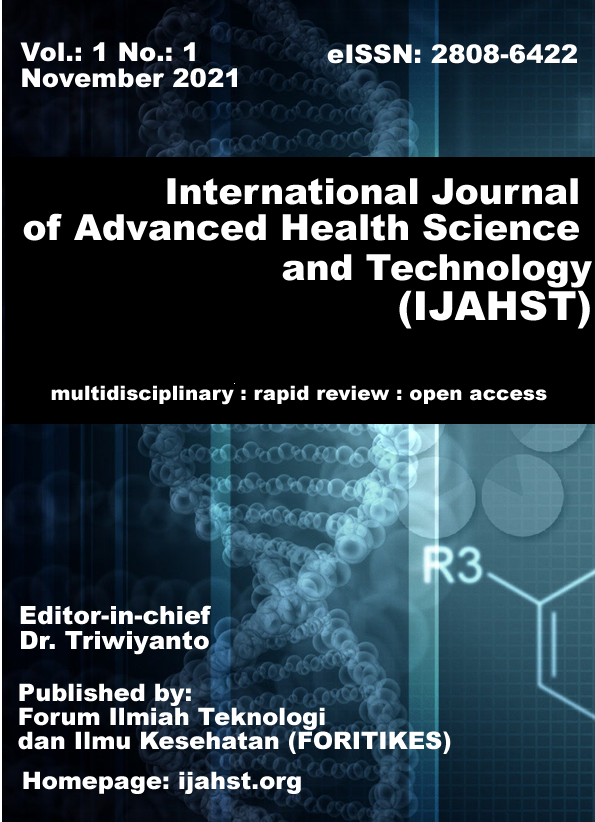Digital ECG Phantom Design to Represent the Human Heart Signal for Early Test on ECG Machine in Hospital
Abstract
Electrocardiograph (ECG) is a diagnostic tool that can record the electrical activity of the human heart. By analyzing the resulting waveforms of the recorded electrical activity of the heart, it is possible to record and diagnose disease. Given the importance of the ECG recording device, it is necessary to check the function of the ECG recording device, namely by performing a device calibration procedure using the Phantom ECG which aims to simulate the ECG signal. The purpose of this research is to check the ECG device during repairs, besides that the Electrocardiograph (EKG) tool functions for research purposes on ECG signals or for educational purposes. Electrocardiograph (EKG) simulator or often called Phantom ECG is in principle a signal generator in the form of an ECG like signal or a recorded ECG signal. This device can be realized based on microcontroller and analog circuit. The advantage of this simulator research is that the ECG signal displayed is the original ECG recording and has an adequate ECG signal database. ECG This simulator also has the advantage of providing convenience for research on digital signal processing applications for ECG signal processing. In its application this simulator can be used as a tool to study various forms of ECG signals. Based on the measurement results, the error value at BPM 30 and 60 is 0.00% at the sensitivity of 0.5mV, 1.0mV, and 2.0mV, then the measurement results for the error value at BPM 120 are 0.33% and at the BPM 180 value, the error value is 0.22%. From these results, it can be concluded that the highest error value is at BPM 120 with sensitivities of 0.5mV, 1.0mV, and 2.0mV.
Full text article
References
Z. Alamanda, A. Pudji, M. R. Makruf, 2016 "Phantom ECG," vol. 28, no. 2, pp. 250–250, 2016,doi:10.4234/jjoffamilysociology.28.250.
Eka Setianingsih, A. S. R, and H. Fitriawan, “Rancang bangun kalibrator eksternal,” vol. 6, no. 2, pp. 127–140, 2012.
Gregorius Mario Tani and Priyambada Cahya Nugraha, Syaifudin) “Seminar Tugas Akhir Simulasi ECG (Phantom electrocardiograph) Berbasis Mikrokontroler, ,” 2017.
N. Nyoman. Sri. Malini, “ECG Simulator,” pp. 1–11, 1990.2014
A. A. Willa Olivia, “Rancang Bangun Kalibrator Elektrokardiogram,” Sinusoida, vol. 19, no. 2, 2017.
G. M. Tani and P. C. Nugraha, “Seminar TugasAkhir Juni Simulasi ECG (Phantom electrocardiograph) Berbasis Mikrokontroler 2. 017.
S. Informasi, J. Naam, and C. Suharinto, “Prosiding seminar nasional sisfotek Digitalisasi Grafik Elektrokardiogram denganTeknik Pixel Indexing,” Pros. Semin. Nas. sisfotek, vol. 1, pp. 172–176, 2017.
Handayani, A.. Sistem Konduksi Jantung. Buletin Farmatera, 2(3), 116. 2017
Valais, I., Koulouras, G., Fountos, G., Michail, C., Kandris, D., & Athinaios, S. Design and Construction of a Prototype ECG Simulator. Journal of Science & Technology, January. http://e- jst.teiath.gr .2014
Elektrokardiograf, R., Komputer, B., & Agung, R.. Realisasi Elektrokardiograf Berbasis Komputer Personal Untuk Akuisisi Data Isyarat Elektris Jantung. Majalah Ilmiah Teknologi Elektro, 4(1), 14–19 .2009.
N. A. Jaenal Arifin1 and 1program, “Pengolahan Citra Pada Sinyal Ekg,” Media Elektr., vol. 11, no. 1, pp. 27–33, 2019.
S. Informasi, J. Naam, and C. Suharinto, “Prosiding seminar nasional sisfotek Digitalisasi Grafik Elektrokardiogram dengan Teknik Pixel Indexing,” Pros. Semin. Nas. sisfotek, vol. 1, pp. 172–176, 2017.
R. Elektrokardiograf, B. Komputer, and R. Agung, “Realisasi Elektrokardiograf Berbasis Komputer Personal Untuk Akuisisi Data Isyarat Elektris Jantung,” Maj. Ilm. Teknol. Elektro, vol. 4, no. 1, pp. 14–19, 2009, doi: 10.24843/10.24843/MITE.
S. H and K. M, “Design and Development of ECG Simulator and Microcontroller Based Displayer,” J. Biosens. Bioelectron., vol. 09, no. 03, 2018, doi: 10.4172/2155-6210.1000256.
O. B. D. Cahyo and N. Kholis, “Rancang Bangun Simulator Elektronik Ardiogram Menggunakan FPGA Yang Terintegrasi Dengan Software Python,” J. Tek. Elektro, vol. 08, no. 03, pp. 619–625, 2019.
M. Saimi, “Rancang Bangun ECG Simulator Menggunakan Digital to Analog Converter R-2R Abstrak,” vol. 7, no. 1, pp. 156–168, 2021.
A. Rizal, I. Y. Setiadi, R. Magdalena, and V. Suryani, “Simulator Ecg Berbasis Pc Sebagai Alat Bantu Ajar Pengolahan Sinyal Biomedis.”
S. E. De Lucena, “ECG simulator for testing and servicing cardiac monitors and electrocardiographs,” 18th IMEKO TC4 Symp. Meas. Electr. Quant. 2011, Part Metrol. 2011, pp. 109–112, 2011.
A.S.Riandi Oktovian1, Suwandi2, “Perancangan Sistem Simulasi Sinyal Ecg Berbasis Mikrokontroler,” Peranc. Sist. Simulasi Sinyal Ecg Berbas. Mikrokontroler, 2018.
A. Pudji, R. Mak, and W. Wirasa, “Design and Build ECG Simulator,” vol. 8, no. 10, pp. 1084–1087, 2019.
M. A. Saputro, E. R. Widasari, and H. Fitriyah, “Implementasi Sistem Monitoring Detak Jantung dan Suhu Tubuh Manusia Secara Wireless,” Pengemb. Teknol. Inf. Dan Ilmu Komput., vol. 1, no. 2, pp. 148– 156, 2017.
Authors
Copyright (c) 2021 International Journal of Advanced Health Science and Technology

This work is licensed under a Creative Commons Attribution-ShareAlike 4.0 International License.
Authors who publish with this journal agree to the following terms:
- Authors retain copyright and grant the journal right of first publication with the work simultaneously licensed under a Creative Commons Attribution-ShareAlikel 4.0 International (CC BY-SA 4.0) that allows others to share the work with an acknowledgement of the work's authorship and initial publication in this journal.
- Authors are able to enter into separate, additional contractual arrangements for the non-exclusive distribution of the journal's published version of the work (e.g., post it to an institutional repository or publish it in a book), with an acknowledgement of its initial publication in this journal.
- Authors are permitted and encouraged to post their work online (e.g., in institutional repositories or on their website) prior to and during the submission process, as it can lead to productive exchanges, as well as earlier and greater citation of published work (See The Effect of Open Access).

